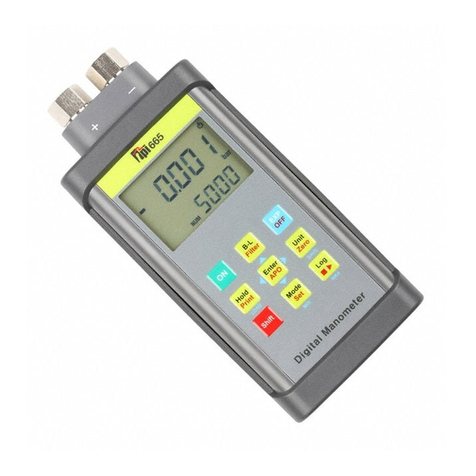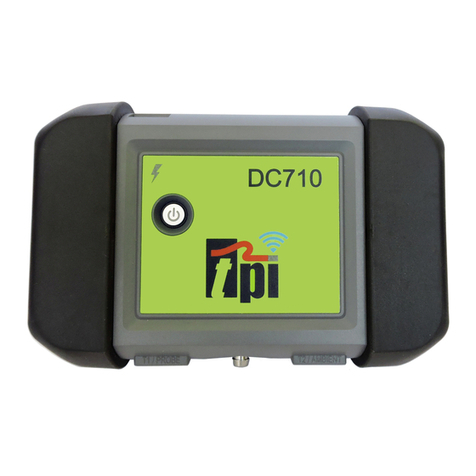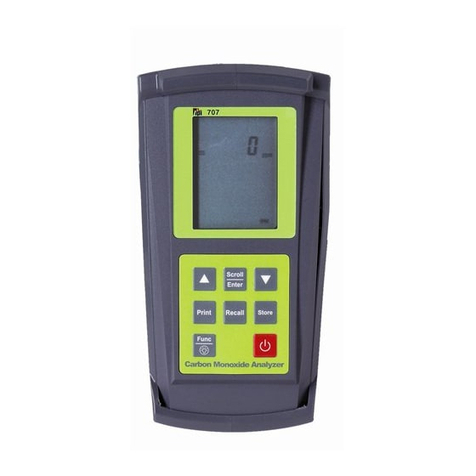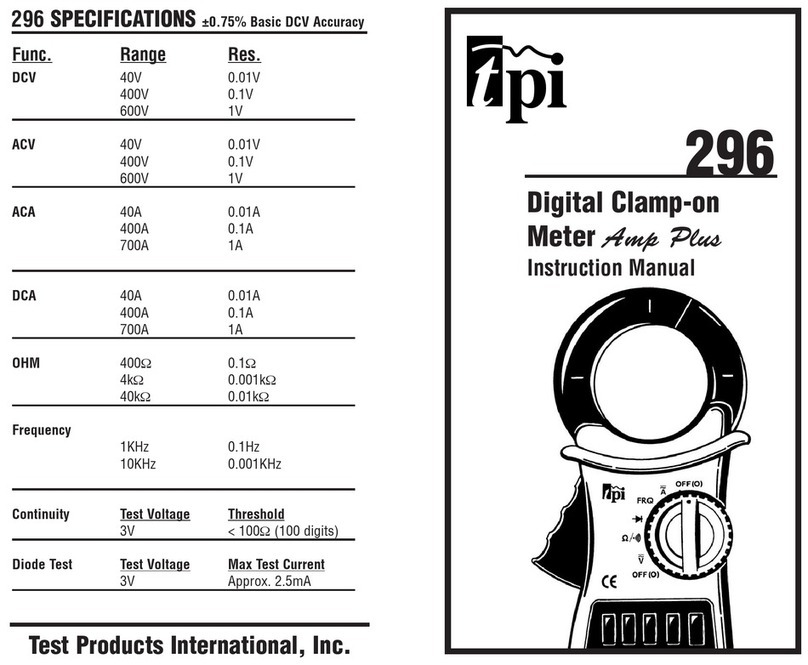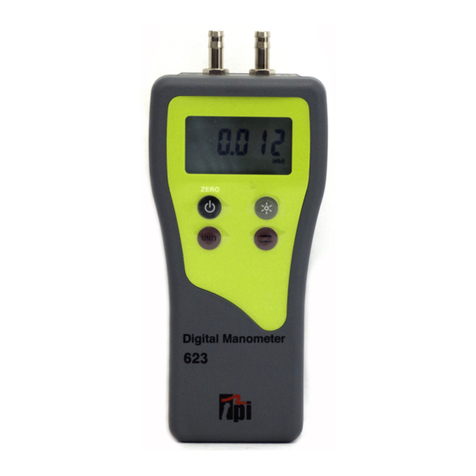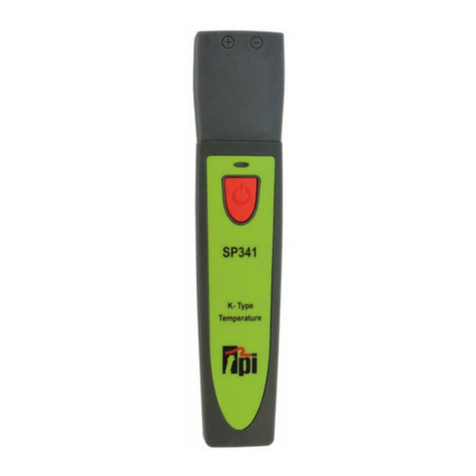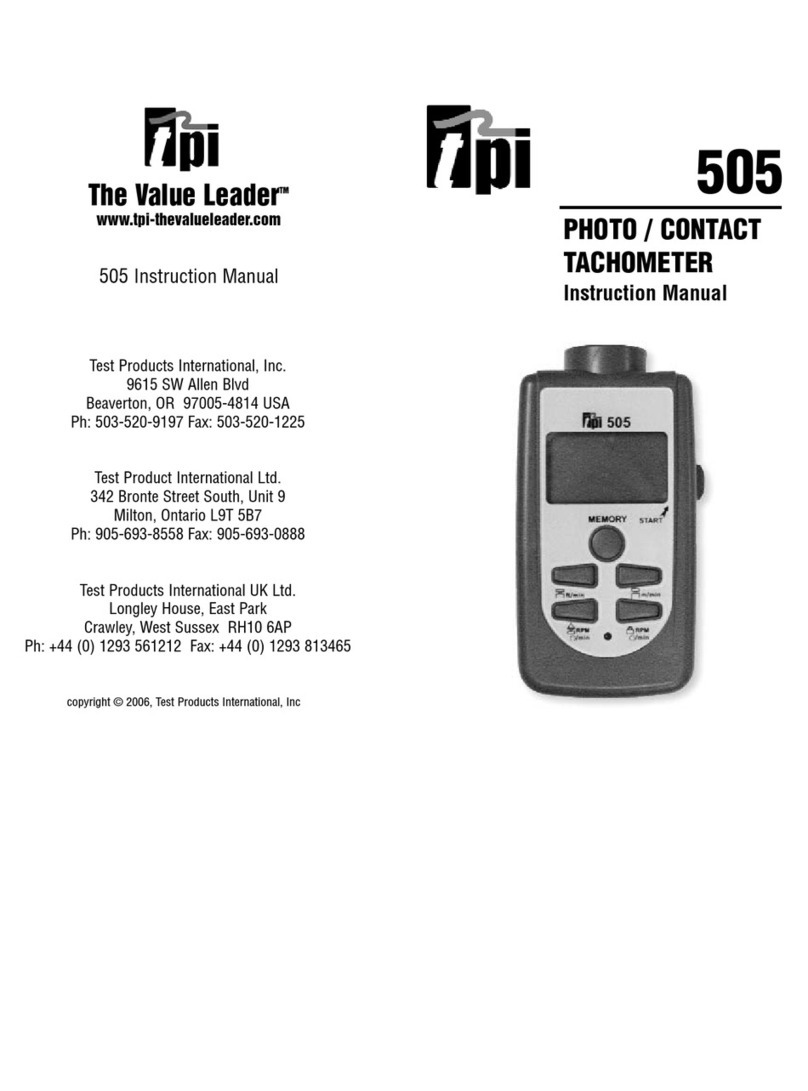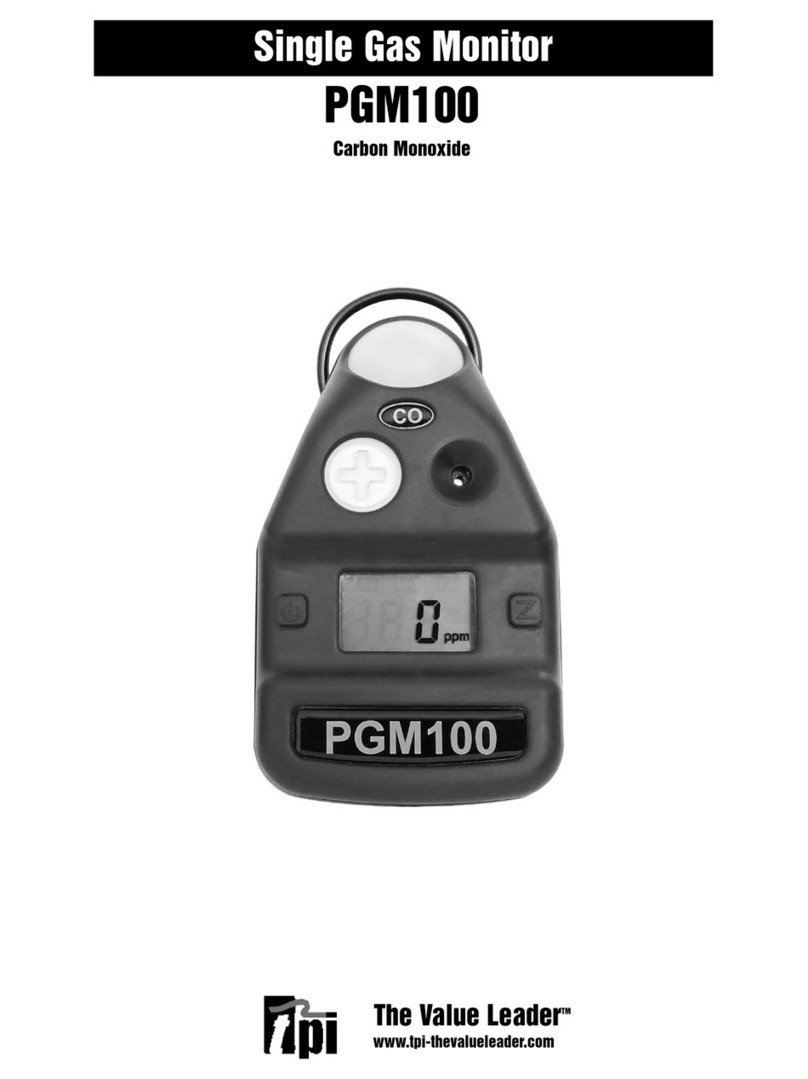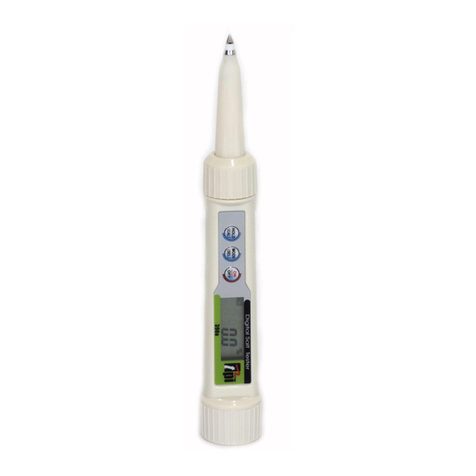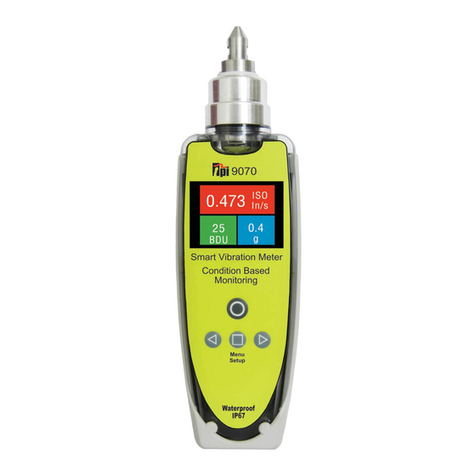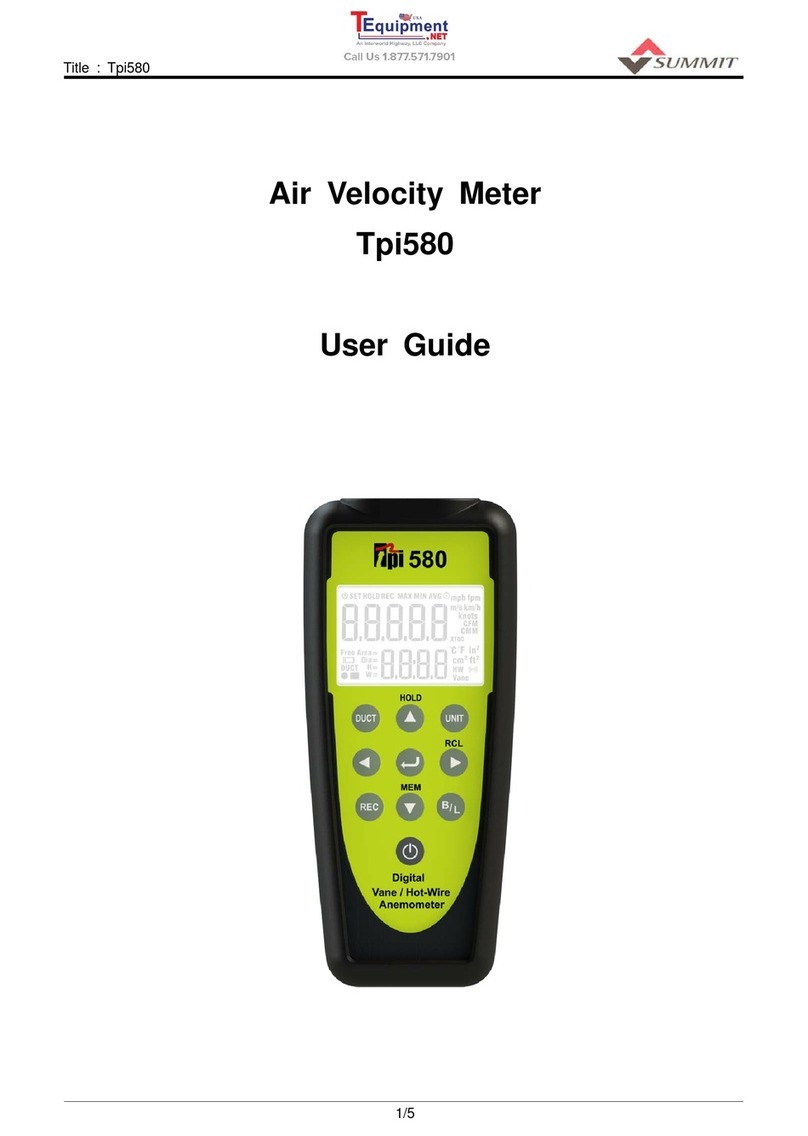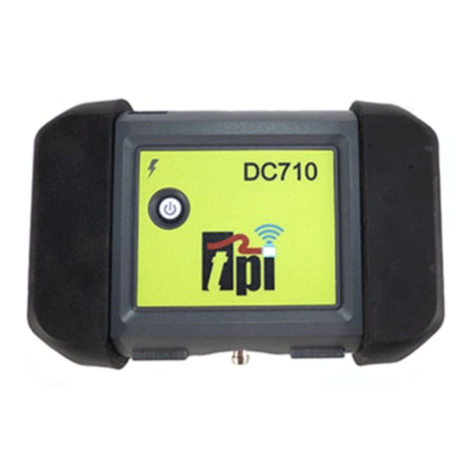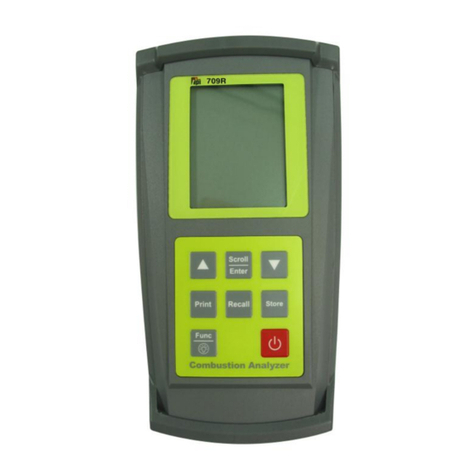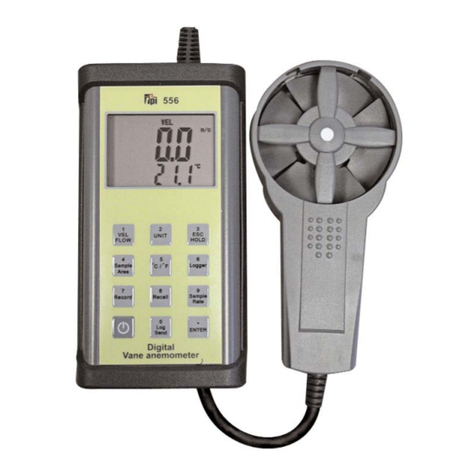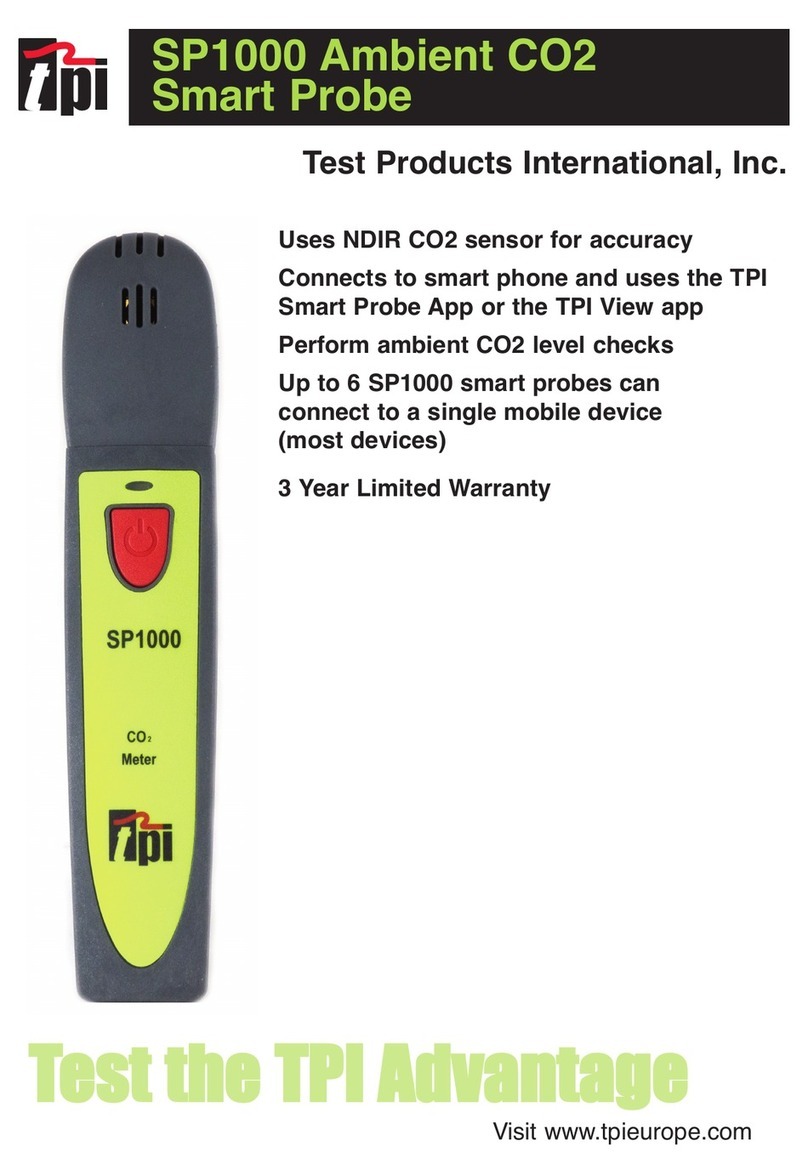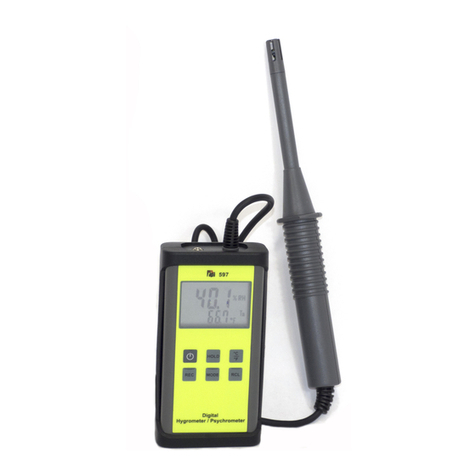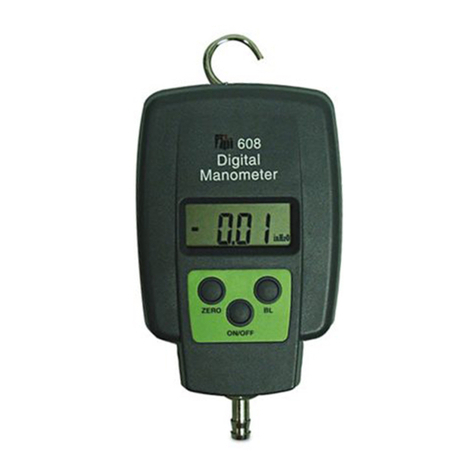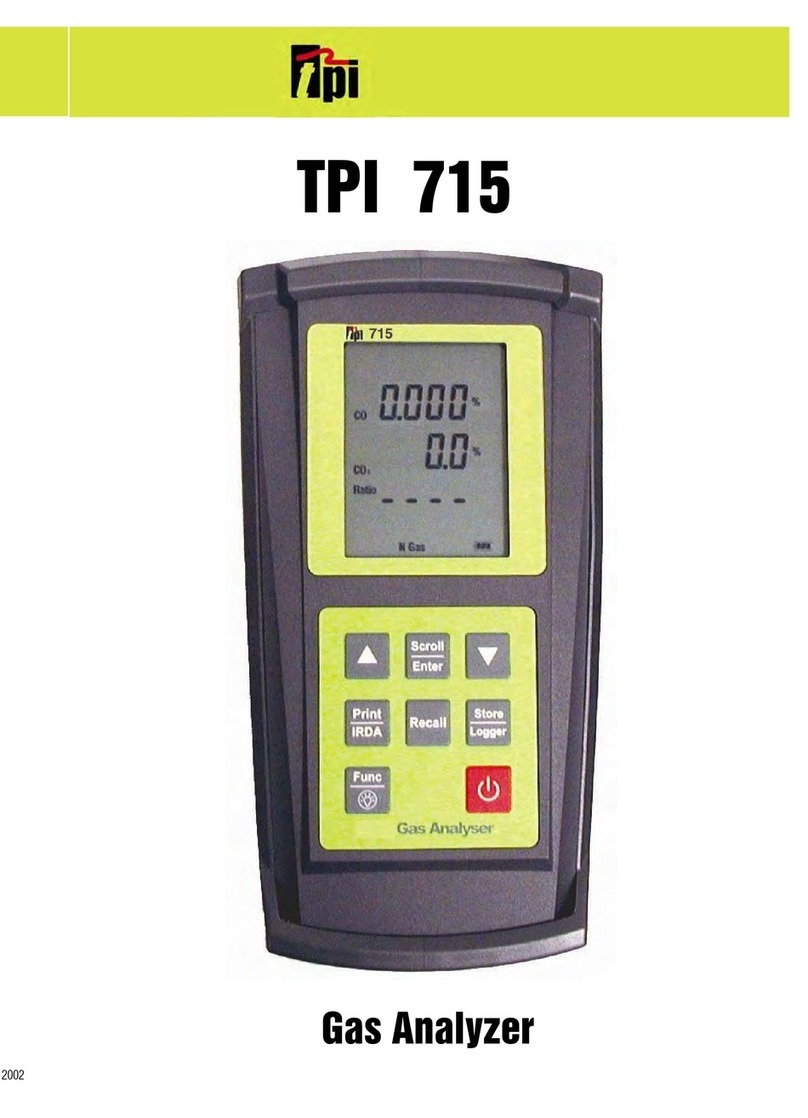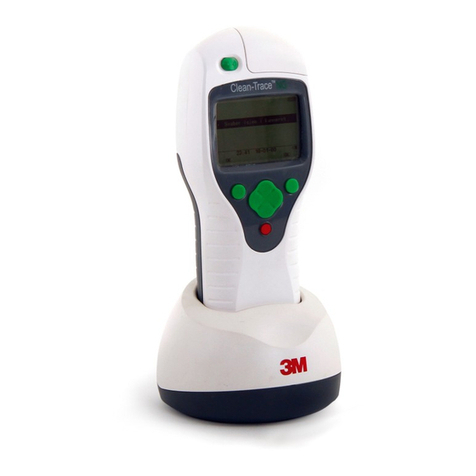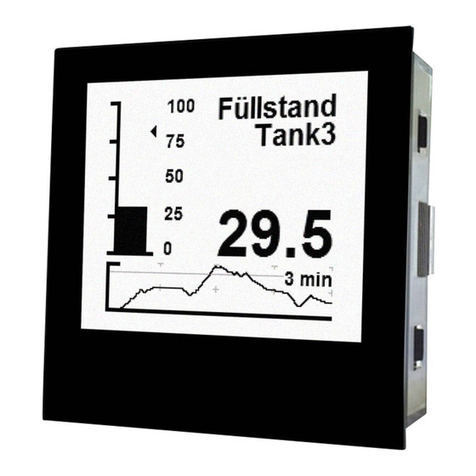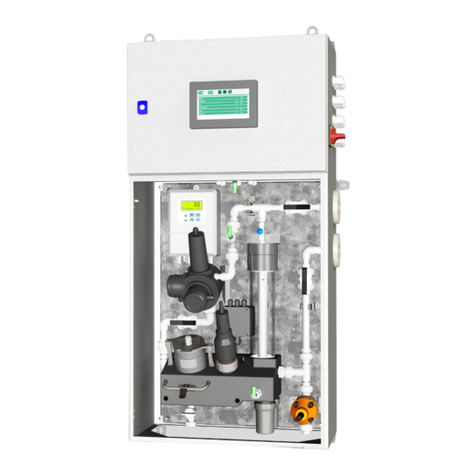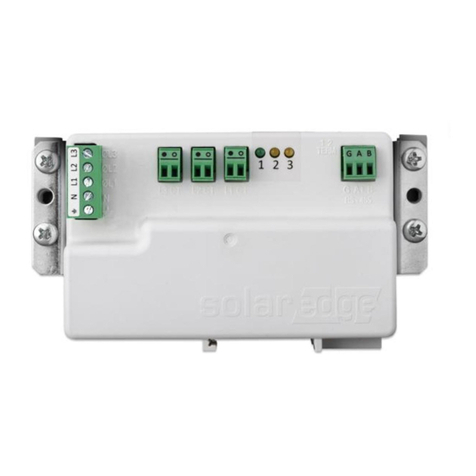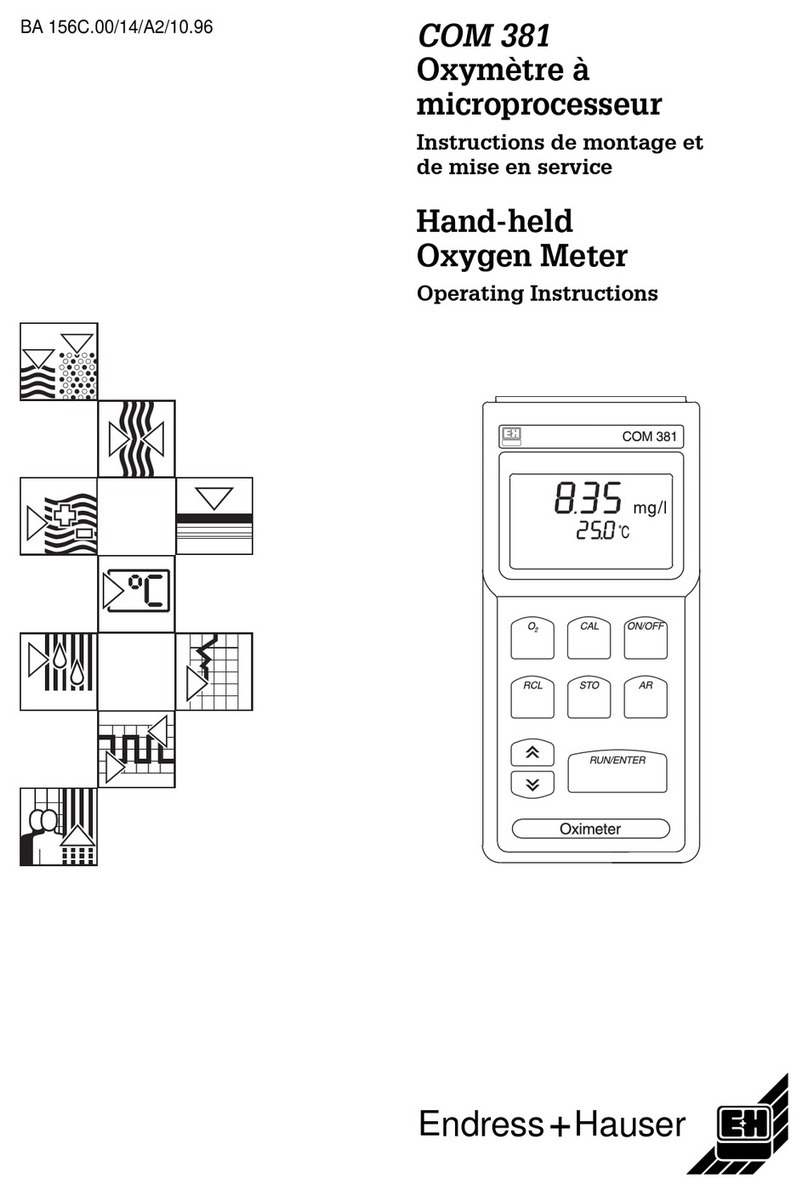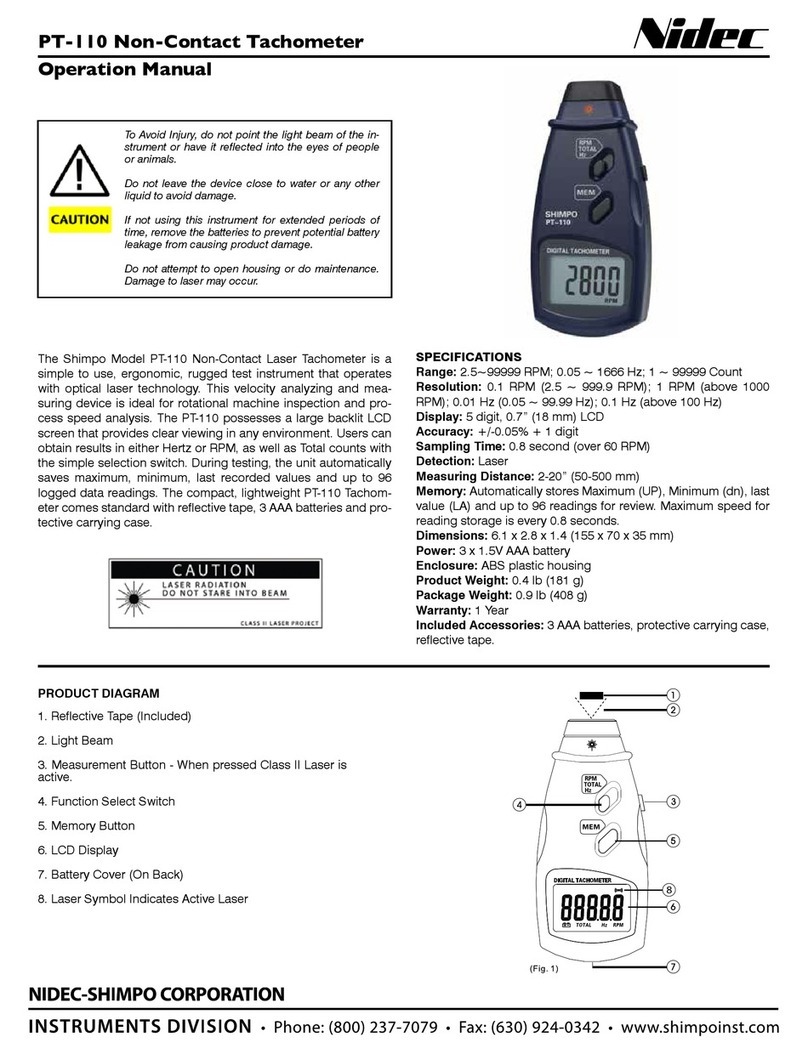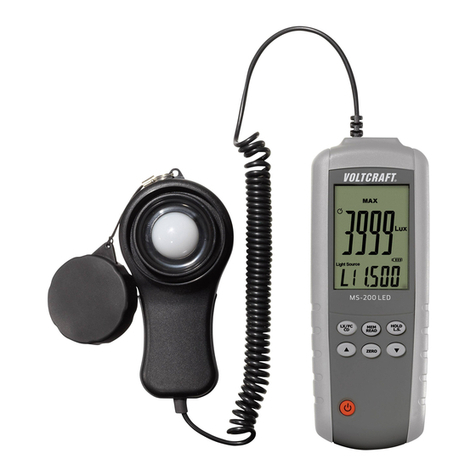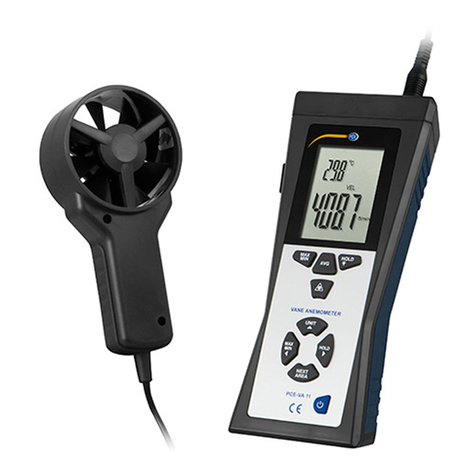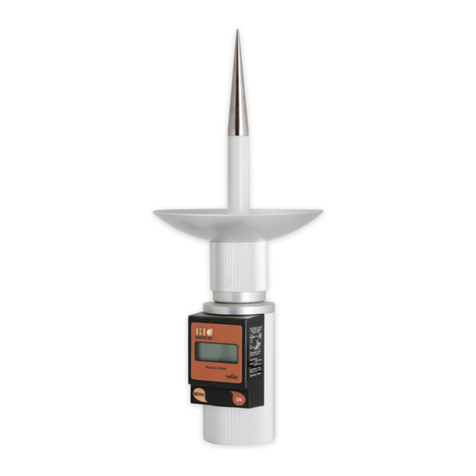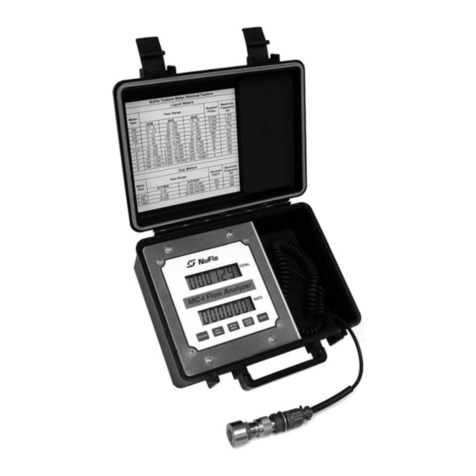TPI Amp Plus 291 User manual

291
Digital Clamp-on
Meter Amp Plus
Instruction Manual

3
2
A. INTRODUCTION
1. Congratulations!!
Thank you for purchasing TPI products. The
Amp Plus is easy to use and is built to last.
It is backed by a 3 year limited warranty.
Please remember to complete and return
your product warranty registration card.
2. Product Description
The 291 is a hand-held manual ranging clamp-on DMM.
The 291 is an affordable choice offering measurements
in all basic electrical functions.
•Bar Graph When measuring frequency, bar
graph indicates current level.
•Peak Mode For start-up and inrush currents.
•Sleep Mode Preserves battery life.
•Data Hold Holds the reading on the display for
easy viewing.
The 291 comes complete with the following accessories:
Carrying Pouch
Test Lead Set
Instruction Manual
Battery
TABLE OF CONTENTS
A. INTRODUCTION
1. Congratulations ..........................3
2. Product Description....................3
3. Declaration of Conformity ..........4
B. SAFETY CONSIDERATIONS ..............5
C. TECHNICAL DATA
1. Features and Benefits..................6
2. Product Applications ..................7
3. Specifications..............................8
D. MEASUREMENT TECHNIQUES
1. Controls and Functions ............10
2. Step by Step Procedures: ........13
E. ACCESSORIES ................................21
F. MAINTENANCE ................................22
G. TROUBLE SHOOTING GUIDE ..........23

3
2
A. INTRODUCTION
1. Congratulations!!
Thank you for purchasing TPI products. The
Amp Plus is easy to use and is built to last.
It is backed by a 3 year limited warranty.
Please remember to complete and return
your product warranty registration card.
2. Product Description
The 291 is a hand-held manual ranging clamp-on DMM.
The 291 is an affordable choice offering measurements
in all basic electrical functions.
•Bar Graph When measuring frequency, bar
graph indicates current level.
•Peak Mode For start-up and inrush currents.
•Sleep Mode Preserves battery life.
•Data Hold Holds the reading on the display for
easy viewing.
The 291 comes complete with the following accessories:
Carrying Pouch
Test Lead Set
Instruction Manual
Battery
TABLE OF CONTENTS
A. INTRODUCTION
1. Congratulations ..........................3
2. Product Description....................3
3. Declaration of Conformity ..........4
B. SAFETY CONSIDERATIONS ..............5
C. TECHNICAL DATA
1. Features and Benefits..................6
2. Product Applications ..................7
3. Specifications..............................8
D. MEASUREMENT TECHNIQUES
1. Controls and Functions ............10
2. Step by Step Procedures: ........13
E. ACCESSORIES ................................21
F. MAINTENANCE ................................22
G. TROUBLE SHOOTING GUIDE ..........23

5
4
B. SAFETY CONSIDERATIONS
WARNING: Please follow manufacturers test
procedures whenever possible. Do not attempt to
measure unknown voltages or components until a
complete understanding of the circuit is obtained.
GENERAL GUIDELINES
ALWAYS
• Test the 291 before using it to make sure it is
operating properly.
• Inspect the test leads before using to make sure there
are no breaks or shorts.
• Double check all connections before testing.
• Have someone check on you periodically if
working alone.
• Have a complete understanding of the circuit
being measured.
• Disconnect power to circuit, then connect test leads to
the 291, then to circuit being measured.
NEVER
• Attempt to measure unknown high voltages.
• Attempt to measure current with the meter in
parallel to the circuit.
• Connect the test leads to a live circuit before
setting up the instrument.
• Touch any exposed metal part of the test lead assembly.
3. EC Declaration of Conformity
This is to certify that TPI Model 291 conforms to the
protection requirements of the council directive
89/336/EEC, in the approximation of laws of the member
states relating to Electromagnetic compatibility and
73/23/EEC. The Low Voltage Directive by application of
the following standards:
EN 50081-1 1992 Emissions Standard
EN 50082-1 1992 Immunity Standard
EN 61010-1 1993 Safety Standard
EN 61010-2-031 1995 Safety Standard
EN 61010-2-032 1995 Safety Standard
To ensure conformity with these standard, this instru-
ment must be operated in accordance with the instruc-
tions and specifications given in this manual.
CAUTION: Even though this instrument complies with
the immunity standards, it’s accuracy can be affected
by strong radio emissions not covered in the above
standards. Sources such as hand-held radio trans-
ceivers, radio and TV transmitters, vehicle radios and
cellular phones generate electromagnetic radiation
that could be induced into the test leads of this instru-
ment. Care should be taken to avoid such situations or
alternatively, check to make sure that the instrument is
not being influence by these emissions.
CAUTION: Please follow manufacturers test proce-
dures whenever possible. Do not attempt to measure
unknown voltages or components until a complete
understanding of the circuit is obtained.
!

5
4
B. SAFETY CONSIDERATIONS
WARNING: Please follow manufacturers test
procedures whenever possible. Do not attempt to
measure unknown voltages or components until a
complete understanding of the circuit is obtained.
GENERAL GUIDELINES
ALWAYS
• Test the 291 before using it to make sure it is
operating properly.
• Inspect the test leads before using to make sure there
are no breaks or shorts.
• Double check all connections before testing.
• Have someone check on you periodically if
working alone.
• Have a complete understanding of the circuit
being measured.
• Disconnect power to circuit, then connect test leads to
the 291, then to circuit being measured.
NEVER
• Attempt to measure unknown high voltages.
• Attempt to measure current with the meter in
parallel to the circuit.
• Connect the test leads to a live circuit before
setting up the instrument.
• Touch any exposed metal part of the test lead assembly.
3. EC Declaration of Conformity
This is to certify that TPI Model 291 conforms to the
protection requirements of the council directive
89/336/EEC, in the approximation of laws of the member
states relating to Electromagnetic compatibility and
73/23/EEC. The Low Voltage Directive by application of
the following standards:
EN 50081-1 1992 Emissions Standard
EN 50082-1 1992 Immunity Standard
EN 61010-1 1993 Safety Standard
EN 61010-2-031 1995 Safety Standard
EN 61010-2-032 1995 Safety Standard
To ensure conformity with these standard, this instru-
ment must be operated in accordance with the instruc-
tions and specifications given in this manual.
CAUTION: Even though this instrument complies with
the immunity standards, it’s accuracy can be affected
by strong radio emissions not covered in the above
standards. Sources such as hand-held radio trans-
ceivers, radio and TV transmitters, vehicle radios and
cellular phones generate electromagnetic radiation
that could be induced into the test leads of this instru-
ment. Care should be taken to avoid such situations or
alternatively, check to make sure that the instrument is
not being influence by these emissions.
CAUTION: Please follow manufacturers test proce-
dures whenever possible. Do not attempt to measure
unknown voltages or components until a complete
understanding of the circuit is obtained.
!

67
INTERNATIONAL SYMBOLS
CAUTION: RISK OF ELECTRIC SHOCK
AC (Alternation Current)
DC (Direct Current)
REFER TO INSTRUCTION MANUAL
GROUND
DOUBLE INSULATION
EITHER DC OR AC
C. TECHNICAL DATA
1. Features and Benefits
Agency UL Listed to U.S. and Canadian
Safety Standards. Meets CE
and IEC 1010.
4000 Count Improves the resolution on all
functions and ranges.
Data Hold Maintains the reading on the
display for hard to reads areas.
Peak Mode Measure the inrush current of
motors, relays and solenoids.
Sleep Mode Automatically powers down
after 10 minutes of inactivity.
2. Product Applications
Perform the following tests and/or measurements with
the 291 and the appropriate function:
HVAC/R
ACA • Heat anticipator current in thermostats.
ACV • Line voltage.
ACV or DCV • Control circuit voltage.
OHMS • Heating element resistance (continuity).
OHMS • Compressor winding resistance.
OHMS • Contactor and relay coil resistance.
ACA • Motor and compressor start up current.
OHMS • Continuity of wiring.
ALL • Bar graph to indicate rapid fluctuations.
ELECTRICAL
ACV • Measure line voltage.
ACA • Measure line current.
OHMS • Continuity of circuit breakers.
DCV • Voltage of direct drive DC motors.
ACA • Start up current of motors, relays,
contactors and transformers.
ELECTRONIC
ACV • Measure power supply voltage.
ACA • Measure power supply current.
OHMS • Continuity of circuit breakers and fuses.
!

67
INTERNATIONAL SYMBOLS
CAUTION: RISK OF ELECTRIC SHOCK
AC (Alternation Current)
DC (Direct Current)
REFER TO INSTRUCTION MANUAL
GROUND
DOUBLE INSULATION
EITHER DC OR AC
C. TECHNICAL DATA
1. Features and Benefits
Agency UL Listed to U.S. and Canadian
Safety Standards. Meets CE
and IEC 1010.
4000 Count Improves the resolution on all
functions and ranges.
Data Hold Maintains the reading on the
display for hard to reads areas.
Peak Mode Measure the inrush current of
motors, relays and solenoids.
Sleep Mode Automatically powers down
after 10 minutes of inactivity.
2. Product Applications
Perform the following tests and/or measurements with
the 291 and the appropriate function:
HVAC/R
ACA • Heat anticipator current in thermostats.
ACV • Line voltage.
ACV or DCV • Control circuit voltage.
OHMS • Heating element resistance (continuity).
OHMS • Compressor winding resistance.
OHMS • Contactor and relay coil resistance.
ACA • Motor and compressor start up current.
OHMS • Continuity of wiring.
ALL • Bar graph to indicate rapid fluctuations.
ELECTRICAL
ACV • Measure line voltage.
ACA • Measure line current.
OHMS • Continuity of circuit breakers.
DCV • Voltage of direct drive DC motors.
ACA • Start up current of motors, relays,
contactors and transformers.
ELECTRONIC
ACV • Measure power supply voltage.
ACA • Measure power supply current.
OHMS • Continuity of circuit breakers and fuses.
!

9
8
e. OHM (Resistance, )
Range Res. Accuracy Overload
Protection
400Ω0.1Ω±1% of reading, ±10 digits 600V DC or
AC Peak
f. Continuity Buzzer
Test Voltage Threshold Over Load Protection
3V < 50Ω(100 digits) 600 V DC or Peak AC
h. General Specifications
Max. Volt. between 600V
any Input and Ground
Display Type 4,000 Count, 4 times per
second update
Operating Temp. -10° to 45°C (14° to 113°F)
Storage Temp. -20° to 55°C (-4° to 131°F)
Relative Humidity 0% to 80% (0° - 35°C/32° - 95°F)
0% to 70% (35° - 50°C/95° - 122°F)
Power Supply 9 Volt Battery
Battery Life 80 hrs. Alkaline
Size (H x L x W) 40mm x 190mm x 65mm
(1.5in x 7.25in x 2.5in)
Weight 315g (11.1oz)
3. Specifications
IEC 1010 Over Voltage:
CAT II - 1000V
CAT III - 600V
Pollution Degree 2
a. DCV
Range Resolution Accuracy Impedance
40V 0.01V ±0.75% of reading, 10MΩ
400V 0.1V ±3 digits
600V 1V
b. ACV
Range Resolution Accuracy Impedance
400V 0.1V ±1.2% of reading, 10MΩ
750V 1V ±3 digits
c. ACA
Range Res. Accuracy Freq. Response
400A 0.1A ±1.5% of reading, 45Hz to 450Hz
700A 1A ±4 digits
UL 3111-1
*Warning: Test Leads. Use only correct type and
overvoltage category rating.
!

9
8
e. OHM (Resistance, )
Range Res. Accuracy Overload
Protection
400Ω0.1Ω±1% of reading, ±10 digits 600V DC or
AC Peak
f. Continuity Buzzer
Test Voltage Threshold Over Load Protection
3V < 50Ω(100 digits) 600 V DC or Peak AC
h. General Specifications
Max. Volt. between 600V
any Input and Ground
Display Type 4,000 Count, 4 times per
second update
Operating Temp. -10° to 45°C (14° to 113°F)
Storage Temp. -20° to 55°C (-4° to 131°F)
Relative Humidity 0% to 80% (0° - 35°C/32° - 95°F)
0% to 70% (35° - 50°C/95° - 122°F)
Power Supply 9 Volt Battery
Battery Life 80 hrs. Alkaline
Size (H x L x W) 40mm x 190mm x 65mm
(1.5in x 7.25in x 2.5in)
Weight 315g (11.1oz)
3. Specifications
IEC 1010 Over Voltage:
CAT II - 1000V
CAT III - 600V
Pollution Degree 2
a. DCV
Range Resolution Accuracy Impedance
40V 0.01V ±0.75% of reading, 10MΩ
400V 0.1V ±3 digits
600V 1V
b. ACV
Range Resolution Accuracy Impedance
400V 0.1V ±1.2% of reading, 10MΩ
750V 1V ±3 digits
c. ACA
Range Res. Accuracy Freq. Response
400A 0.1A ±1.5% of reading, 45Hz to 450Hz
700A 1A ±4 digits
UL 3111-1
*Warning: Test Leads. Use only correct type and
overvoltage category rating.
!

11
10
1. Controls and Functions: (cont.)
Input Jacks
COM Black test lead connection for
ACV, DCV, Ω, Continuity Buzzer
and Diode Test functions.
V/ΩΩRed test lead connection for all
ACV, DCV, Ω, Continuity Buzzer
and Diode Test functions.
D. MEASUREMENT TECHNIQUES
1. Controls and Functions:
Push Buttons
PEAK Activates the Peak Hold function
(ACA only.)
HOLD Holds the reading on the display
until the button is pushed a
second time.
Rotary Switch
OFF Turns the 291 completely off.
VUsed to measure DC volts.
VUsed to measure AC volts.
ΩΩUsed to measure resistance and
use the continuity buzzer.
AUsed to measure AC amps.

11
10
1. Controls and Functions: (cont.)
Input Jacks
COM Black test lead connection for
ACV, DCV, Ω, Continuity Buzzer
and Diode Test functions.
V/ΩΩRed test lead connection for all
ACV, DCV, Ω, Continuity Buzzer
and Diode Test functions.
D. MEASUREMENT TECHNIQUES
1. Controls and Functions:
Push Buttons
PEAK Activates the Peak Hold function
(ACA only.)
HOLD Holds the reading on the display
until the button is pushed a
second time.
Rotary Switch
OFF Turns the 291 completely off.
VUsed to measure DC volts.
VUsed to measure AC volts.
ΩΩUsed to measure resistance and
use the continuity buzzer.
AUsed to measure AC amps.

13
12
2. Step by Step Procedures:
a. Measuring DC Volts
WARNING!
Do not attempt to make a voltage measurement of
more than 600V or of a voltage level that is unknown.
Instrument set-up:
FUNC. BLACK RED MIN MAXI
TEST LEAD TEST LEAD READING READING
V COM V/Ω0.1mV 750V
Measurement Procedure:
1. Disconnect power to circuit to be measured.
2. Plug black test lead into the COM input jack.
3 Plug red test lead into the V/Ωinput jack.
4. Set rotary switch to the appropriate V range.
5. Connect test leads to circuit to be measured.
6. Reconnect power to circuit to be measured.
7. Read the voltage on the 291.
Optional Modes
•HOLD: Freezes the reading on the LCD.
•PEAK: Measures the peak voltage.
!
Application Notes
When measuring DC Voltage of a bat-
tery, the most accurate reading can be
attained by testing the battery under
load. To accomplish this, follow steps
1 through 4 shown on page 13 and
the following (with the battery in
holder and device turned on):
• Connect the red test lead from the
meter to the positive (+) terminal
of the battery.
• Connect the black test lead to the
negative (-) terminal of the battery.
• Reconnect power to the circuit and
read the voltage on the 291.

13
12
2. Step by Step Procedures:
a. Measuring DC Volts
WARNING!
Do not attempt to make a voltage measurement of
more than 600V or of a voltage level that is unknown.
Instrument set-up:
FUNC. BLACK RED MIN MAXI
TEST LEAD TEST LEAD READING READING
V COM V/Ω0.1mV 750V
Measurement Procedure:
1. Disconnect power to circuit to be measured.
2. Plug black test lead into the COM input jack.
3 Plug red test lead into the V/Ωinput jack.
4. Set rotary switch to the appropriate V range.
5. Connect test leads to circuit to be measured.
6. Reconnect power to circuit to be measured.
7. Read the voltage on the 291.
Optional Modes
•HOLD: Freezes the reading on the LCD.
•PEAK: Measures the peak voltage.
!
Application Notes
When measuring DC Voltage of a bat-
tery, the most accurate reading can be
attained by testing the battery under
load. To accomplish this, follow steps
1 through 4 shown on page 13 and
the following (with the battery in
holder and device turned on):
• Connect the red test lead from the
meter to the positive (+) terminal
of the battery.
• Connect the black test lead to the
negative (-) terminal of the battery.
• Reconnect power to the circuit and
read the voltage on the 291.

15
14
b. Measuring AC Volts
WARNING!
Do not attempt to make a voltage measurement of
more than 600V or of a voltage level that is unknown.
Instrument set-up:
FUNC. BLACK RED MIN MAX
TEST LEAD TEST LEAD READING READING
V COM V/Ω0.1mV 750V
Measurement Procedure:
1. Disconnect power to circuit to be measured.
2. Plug black test lead into COM input jack.
3. Plug red test lead into V/Ωinput jack.
4. Set the rotary switch to the appropriate V function.
5. Connect test leads to circuit to be measured.
6. Reconnect power to circuit to be measured.
7. Read the voltage on the 291.
Optional Modes
•HOLD: Freezes the reading on the LCD.
•PEAK: Measures the peak voltage.
!
Application Notes
Disconnect power from the
terminal block, find the fuse or
circuit breaker that controls
the block and turn it off.
Set up the meter following the
steps under “Measurement
Procedure” on page 15. Then
proceed with the following:
• Connect the red test lead to
the hot side of the block and the
black lead to the neutral side of the block.
Reconnect power to the block and read the
voltage on the meter. The reading should be
approximately 110V to 130V.
• Disconnect power from the block and move
the red wire to ground. Reconnect power to
the block and read the voltage on the meter.
Typically less than 20V should exist from
neutral to ground. If 110V or above exists,
the block may be wired incorrectly.

15
14
b. Measuring AC Volts
WARNING!
Do not attempt to make a voltage measurement of
more than 600V or of a voltage level that is unknown.
Instrument set-up:
FUNC. BLACK RED MIN MAX
TEST LEAD TEST LEAD READING READING
V COM V/Ω0.1mV 750V
Measurement Procedure:
1. Disconnect power to circuit to be measured.
2. Plug black test lead into COM input jack.
3. Plug red test lead into V/Ωinput jack.
4. Set the rotary switch to the appropriate V function.
5. Connect test leads to circuit to be measured.
6. Reconnect power to circuit to be measured.
7. Read the voltage on the 291.
Optional Modes
•HOLD: Freezes the reading on the LCD.
•PEAK: Measures the peak voltage.
!
Application Notes
Disconnect power from the
terminal block, find the fuse or
circuit breaker that controls
the block and turn it off.
Set up the meter following the
steps under “Measurement
Procedure” on page 15. Then
proceed with the following:
• Connect the red test lead to
the hot side of the block and the
black lead to the neutral side of the block.
Reconnect power to the block and read the
voltage on the meter. The reading should be
approximately 110V to 130V.
• Disconnect power from the block and move
the red wire to ground. Reconnect power to
the block and read the voltage on the meter.
Typically less than 20V should exist from
neutral to ground. If 110V or above exists,
the block may be wired incorrectly.

17
16
Application Notes
When measuring AC Amps of a motor there
are two types of measurements that can be
made, running current and in-rush or start-up
current. Start-up current will usually be much
higher than running current.
Set up the meter following the steps under
“Measurement Procedure” on page 16, and
then proceed with the following:
• Clamp the meter around a single wire
and reconnect power to the device. Read
the current displayed on the meter. This
is the running current of the motor.
• Disconnect power to the motor and put
the meter in PEAK HOLD mode.
Reconnect the power and read
the current displayed on the
meter. This is the in-rush or
start-up current
of the motor.
c. Measuring AC Amps
CAUTION!
Do not attempt to make a current measurement with
the test leads. The 291 measures the current by
clamping the jaw around one conductor (wire).
Clamping around more than one wire will result in
erroneous readings.
Instrument set-up:
FUNC. BLACK RED MIN MAX
TEST LEAD TEST LEAD READING READING
A NOT USED NOT USED 0.01A 700A
Measurement Procedure:
1. Disconnect power to circuit to be measured.
2. Set rotary switch to A function.
3. Clamp the jaws around one conductor of the circuit
to be measured.
4. Reconnect power to circuit to be measured.
5. Read the current on the 291.
Optional Modes
•HOLD: Freezes the reading on the LCD.
•PEAK: Measures the peak amperage.

17
16
Application Notes
When measuring AC Amps of a motor there
are two types of measurements that can be
made, running current and in-rush or start-up
current. Start-up current will usually be much
higher than running current.
Set up the meter following the steps under
“Measurement Procedure” on page 16, and
then proceed with the following:
• Clamp the meter around a single wire
and reconnect power to the device. Read
the current displayed on the meter. This
is the running current of the motor.
• Disconnect power to the motor and put
the meter in PEAK HOLD mode.
Reconnect the power and read
the current displayed on the
meter. This is the in-rush or
start-up current
of the motor.
c. Measuring AC Amps
CAUTION!
Do not attempt to make a current measurement with
the test leads. The 291 measures the current by
clamping the jaw around one conductor (wire).
Clamping around more than one wire will result in
erroneous readings.
Instrument set-up:
FUNC. BLACK RED MIN MAX
TEST LEAD TEST LEAD READING READING
A NOT USED NOT USED 0.01A 700A
Measurement Procedure:
1. Disconnect power to circuit to be measured.
2. Set rotary switch to A function.
3. Clamp the jaws around one conductor of the circuit
to be measured.
4. Reconnect power to circuit to be measured.
5. Read the current on the 291.
Optional Modes
•HOLD: Freezes the reading on the LCD.
•PEAK: Measures the peak amperage.

19
18
d. Measuring Resistance
WARNING!
Do not attempt to make resistance measurements with
circuit energized. For best results, remove the resistor
completely from circuit before attempting to measure it.
NOTE:
To make accurate low ohm measurements, short the
ends of the test leads together and record the resistance
reading. Deduct this value from actual readings.
Instrument set-up:
FUNC. BLACK RED MIN MAX
TEST LEAD TEST LEAD READING READING
ΩCOM V/Ω0.1Ω400Ω
Measurement Procedure:
1. Disconnect power to circuit to be measured.
2. Plug black test lead into the COM input jack.
3. Plug red test lead into V/Ωinput jack.
4. Set the rotary switch to the 400 Ωfunction.
5. Connect test leads to circuit to be measured.
6. Read the resistance value on the 291.
Optional Modes
•HOLD: Freezes the reading on the LCD.
!
Application Notes (Resistance)
When measuring resistance of a motor, make
sure the power is disconnected prior to testing.
Set up meter following steps under
“Measurement Procedure” on page 19, and
proceed with the following:
• Connect the red test lead to one power
input line of the motor and the black test
lead to the other power input line of the
motor. In most applications if the reading
is OFL, the motor winding is open.
• Connect the red test lead to the frame of
the motor and the black test lead to the
winding. In most applications if a reading
of 0 Ohms is displayed, the winding is
shorted to the motor frame (ground).

19
18
d. Measuring Resistance
WARNING!
Do not attempt to make resistance measurements with
circuit energized. For best results, remove the resistor
completely from circuit before attempting to measure it.
NOTE:
To make accurate low ohm measurements, short the
ends of the test leads together and record the resistance
reading. Deduct this value from actual readings.
Instrument set-up:
FUNC. BLACK RED MIN MAX
TEST LEAD TEST LEAD READING READING
ΩCOM V/Ω0.1Ω400Ω
Measurement Procedure:
1. Disconnect power to circuit to be measured.
2. Plug black test lead into the COM input jack.
3. Plug red test lead into V/Ωinput jack.
4. Set the rotary switch to the 400 Ωfunction.
5. Connect test leads to circuit to be measured.
6. Read the resistance value on the 291.
Optional Modes
•HOLD: Freezes the reading on the LCD.
!
Application Notes (Resistance)
When measuring resistance of a motor, make
sure the power is disconnected prior to testing.
Set up meter following steps under
“Measurement Procedure” on page 19, and
proceed with the following:
• Connect the red test lead to one power
input line of the motor and the black test
lead to the other power input line of the
motor. In most applications if the reading
is OFL, the motor winding is open.
• Connect the red test lead to the frame of
the motor and the black test lead to the
winding. In most applications if a reading
of 0 Ohms is displayed, the winding is
shorted to the motor frame (ground).

21
g. Peak Mode
Set the 291 to either the 400 or 700 ACA range and
allow the reading on the LCD to settle down to
zero. Clamp the jaw around one wire of the device
the peak current is to be measured from and again
allow the LCD to settle down to zero. Apply power
to the device and read the initial current draw by
the device being measured.
E. ACCESSORIES*
20
e. Continuity Buzzer
WARNING!
Do not attempt to make continuity measurements with
circuit energized.
Instrument set-up:
FUNC. BLACK RED
TEST LEAD TEST LEAD
ΩCOM V/Ω
Measurement Procedure:
1. Disconnect power to circuit to be measured.
2. Plug black test lead into the COM input jack.
3. Plug red test lead into V/Ωinput jack.
4. Set the rotary switch to the Ωfunction.
5. Connect test leads to circuit to be measured.
6. Listen for the buzzer to confirm continuity.
Optional Modes
•HOLD: Freezes the reading on the LCD.
f. Data Hold
Press the HOLD button at any time on any function
to freeze the reading on the LCD display. This
function is very useful when measuring in loca-
tions where the display is difficult to read.
!
Standard Accessories Part No.
9 Volt Alkaline Battery A009A
Test Lead Set A040
Soft Carrying Pouch A200
Optional Accessories Part No.
Deluxe Test Lead Set SDK1C
IEC 1010 Deluxe Test Lead Kit TLS2000BC
Hard Carrying Case A201
*These accessories have not been evaluated by UL and are not
considered as part of the UL Listing of this product.
This manual suits for next models
2
Table of contents
Other TPI Measuring Instrument manuals
Popular Measuring Instrument manuals by other brands

ANTEK
ANTEK 9000 Series Installation, operation & service manual
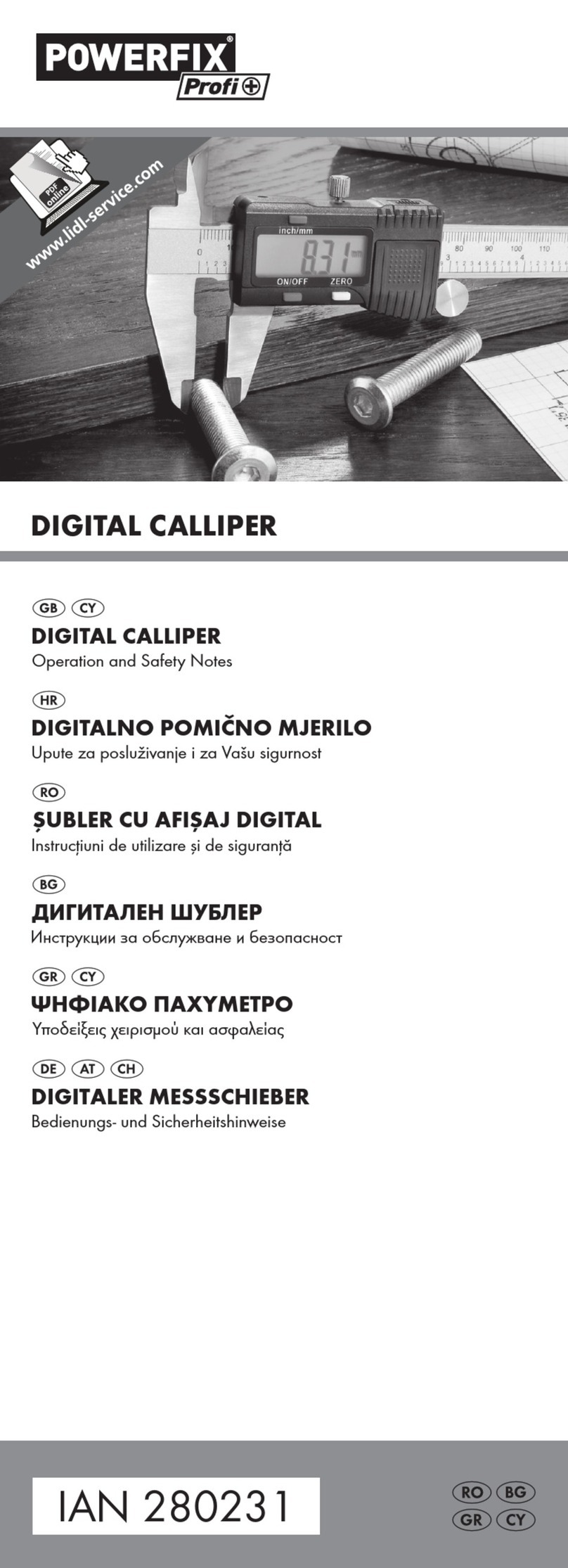
Powerfix Profi
Powerfix Profi 280231 Operation and safety notes
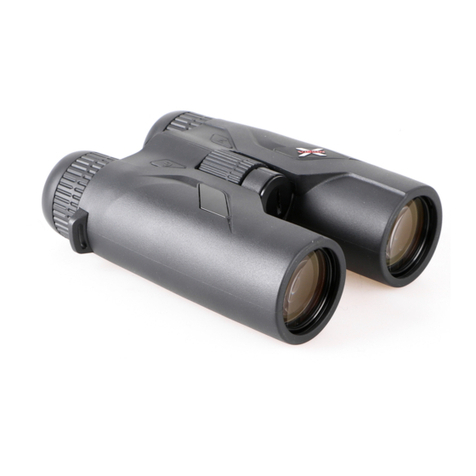
X-Vision Optics
X-Vision Optics ROC 8X user manual
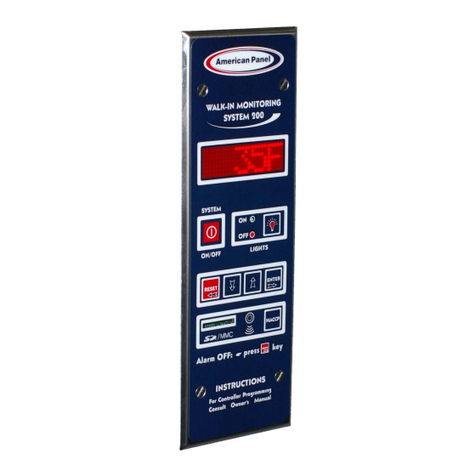
American Panel
American Panel Walk-in Monitoring System 200 owner's manual
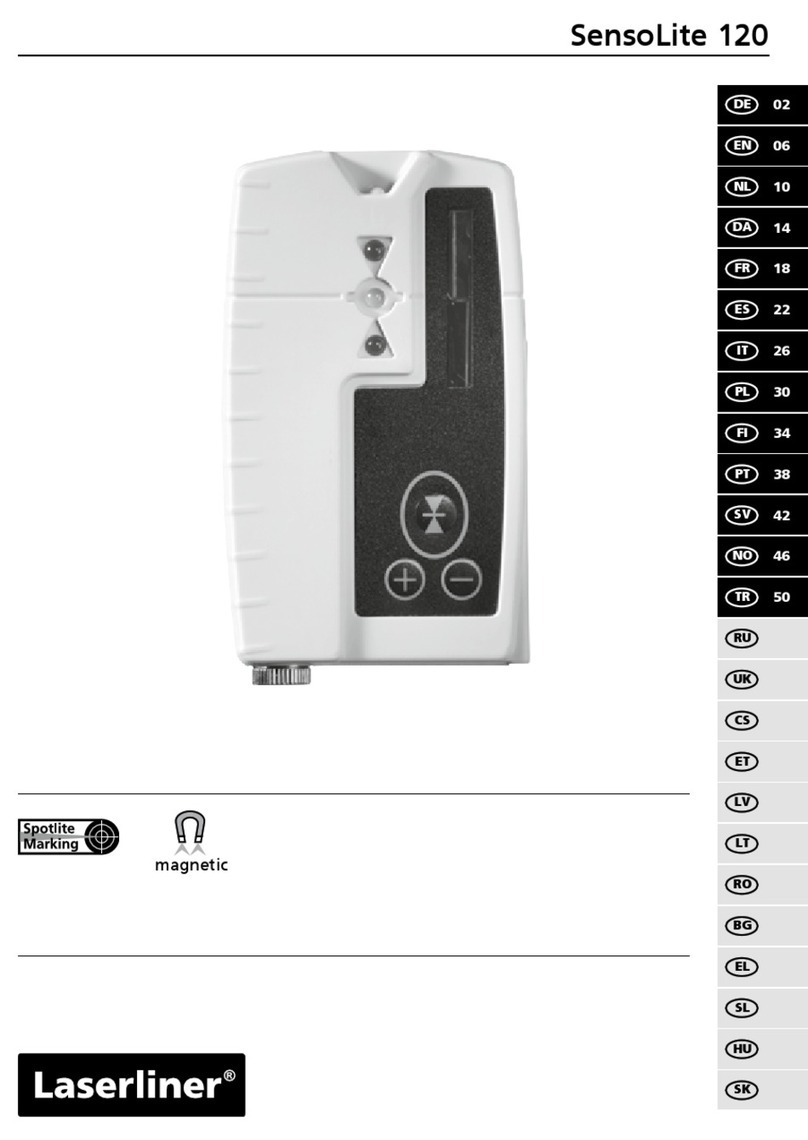
LaserLiner
LaserLiner SensoLite 120 quick start guide

Bender
Bender RCMB-35-30 Series quick start guide

